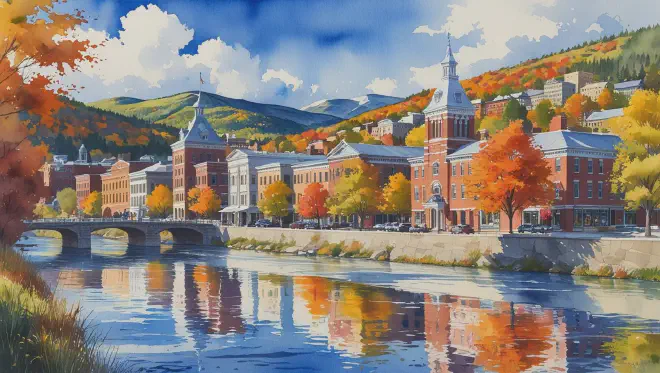Introduction: The Quiet Charm of a Small Capital
With a population of fewer than 10,000 residents, Montpelier stands as one of America’s smallest state capitals. Nestled in central Vermont, cradled by the Green Mountains, this modest city exists in perfect contrast to the clamor of major metropolitan areas. There are no flashy tourist attractions here, yet many find themselves captivated by its understated beauty.
The golden dome of the beautiful Greek Revival State House has crowned the hill for over a century and a half, serving as the city’s beacon while the surrounding five-block downtown buzzes with locally-owned shops that reflect the character of their proprietors. This is a place that manages to be both the center of political power and utterly unpretentious, radiating a human warmth that larger cities often struggle to maintain.
What makes this city truly special is Vermont’s celebrated maple syrup culture. From late spring through early summer, the surrounding countryside comes alive with the ancient ritual of collecting sap from sugar maple trees, their sweet fragrance carrying on the mountain breeze. The farmers market becomes a gathering place where local producers display their carefully tended vegetables and handcrafted goods, fostering genuine connections between neighbors and visitors alike.
I chose Montpelier because I yearned to escape the noise and find a space for quiet reflection. Two nights and three days in this small capital, surrounded by pristine nature, promised to leave a lasting impression on my soul.

Day 1: Welcomed by the Golden Dome
On a crisp morning in early June, after a three-hour drive northwest from Boston, the outline of Montpelier finally emerged from the rolling hills. The first thing to catch my eye was, inevitably, the State House’s golden dome. Catching the soft morning light, it gleamed like a precious jewel against the deep green backdrop of surrounding hills. In this setting of forested ridges, its elegant silhouette was breathtaking.
After checking into a cozy bed and breakfast, I headed straight for the city center. Main Street proved even more compact than I had imagined—a leisurely ten-minute walk could take you from one end to the other. Yet within this brief stretch, an impressive collection of distinctive shops clustered together. A store specializing in handknit sweaters and woolen goods, galleries showcasing local artists’ work, a bookshop where vintage volumes were lovingly arranged. Each establishment radiated the kind of personal warmth you’d never find in big-city chain stores.
For lunch, I followed a local’s recommendation to a small cafe where, true to Vermont tradition, several dishes featured maple syrup. I ordered pancakes topped with local bacon and pure maple syrup. The first bite revealed the syrup’s deep, complex sweetness spreading slowly across my palate. This was clearly different from any maple syrup I’d tasted before—rich, nuanced, almost mystical in its intensity. It seemed to capture the very essence of the forest, concentrated into liquid form.
The afternoon brought a guided tour of the State House. The golden dome, I learned, symbolizes one of the oldest continuously used legislative chambers in the nation. Inside, marble floors harmonized beautifully with wooden accents, creating a space of dignified grandeur. According to our guide, this building has stood since 1859, serving as Vermont’s political heart for over 160 years. From the gallery overlooking the legislative chamber, I gazed down at the seats where American democracy has played out through generations—a truly sacred space.
As evening approached, I climbed to Hubbard Park, home to a historic observation tower on the city’s eastern hills. This park serves as a beloved gathering place for locals. Climbing the 54 stone steps to the tower’s summit, I was rewarded with a panoramic view of Montpelier spread below. The western sky began to glow orange, and the State House dome caught the sunset, blazing gold against the deepening twilight. The surrounding mountains wore their summer coat of deep green, and the serene beauty of it all felt cleansing to my spirit.
That evening, I sat by the fireplace at the B&B with my hosts, sharing local maple beer while learning about Vermont’s history and culture. Maple syrup production, they explained, has been a regional tradition for over two centuries. The brief window for sap collection each spring mobilizes entire communities in frenzied activity. Outside, only the occasional passing car disturbed the profound quiet that city dwellers rarely experience.
Day 2: The Forest’s Rhythm and Maple’s Sweet Legacy
Bird song gently pulled me from sleep. Through my window, I watched squirrels leap from branch to branch in an elaborate morning dance. Savoring the privilege of waking in such natural surroundings, I dressed slowly, mindfully.
Breakfast was served in the B&B’s garden. Homemade muffins, fresh berries, and most memorably, yogurt made from milk delivered that morning by a neighboring farm, drizzled with local maple syrup. This simple meal, enjoyed in the crisp morning air, resonated more deeply than any elaborate restaurant feast I could remember.
The morning took me to Morse Farm Maple Sugarworks, about fifteen minutes north of town. This family operation has been crafting maple syrup for four generations. The farm’s patriarch greeted me with a warm smile and genuine enthusiasm for sharing his craft.
Watching the maple syrup production process revealed the remarkable dedication required. Sugar maples must be at least forty years old before they can be tapped, and each tree yields barely a gallon of sap per day. This precious liquid must then be boiled down at a ratio of 40-to-1 to produce a single quart of finished syrup. “We’re just custodians of nature’s gift,” the farmer explained. His words embodied the harmonious relationship between human skill and natural bounty.
Tasting the fresh syrup was like experiencing the soul of the forest in concentrated form. Different grades revealed subtle distinctions in color and flavor—Light Amber collected early in the season offered delicate, refined sweetness, while late-season Dark Amber delivered robust, complex depth. Each variety possessed its own character, each unforgettable in its own way.
Lunch consisted of homemade maple cookies and herbal tea prepared by the farmer’s wife. The cookies, sweetened with maple sugar, carried a rustic yet sophisticated flavor that lingered pleasantly. The farm’s dog dozed contentedly in a sunny spot while chickens wandered the yard in unhurried exploration. Time seemed to flow differently in this space, reminding me of the “leisure” I’d forgotten in urban life’s relentless pace.
The afternoon brought me to Capitol City Farmers Market, established in 1977 and connecting local producers with consumers for over forty years. Saturday’s market bustled with locals and visitors alike. Fresh vegetables, artisanal breads, preserves, honey, and handicrafts—every vendor’s stall revealed the maker’s personal touch.
Particularly memorable was a local woman running a jam stand. She grew her own berries and created preserves using only natural ingredients, no artificial additives. Sampling her strawberry jam revealed pure fruit essence—nothing masked or enhanced artificially. “I use no chemicals whatsoever,” she said with a bright smile. “Time and love are my only secret ingredients.” Her dedication embodied the true spirit of craftsmanship.
Late afternoon found me exploring hiking trails southeast of Montpelier. The area boasts miles of well-maintained paths for hiking, cycling, and winter skiing. Following a trail that wound through towering beech and maple groves, I soon discovered a pristine stream. The water ran so clear I could see every stone on the bottom.
Resting beside the creek, I was joined by curious squirrels and chipmunks who approached with endearing boldness. In the profound quiet—only bird calls and flowing water—I felt absorbed into the natural world. For these precious moments, daily stress and urban anxiety seemed like distant memories from another lifetime.
Evening brought me back to town for dinner at a pub recommended by locals. I ordered Vermont beer alongside locally-caught trout grilled to perfection and pork chops glazed with maple syrup. Each dish celebrated regional ingredients through simple preparation that allowed natural flavors to shine. Conversation with a fellow diner revealed his story—born and raised here, he’d left for city life before returning, drawn back by irreplaceable qualities. “There’s a richness here that cities can’t offer,” he reflected. His words struck deep.
Day 3: Morning’s Farewell and Lasting Warmth
I woke earlier than usual on this final morning, consciousness gently nudged awake by the awareness that departure loomed. Outside my window, morning mist drifted silently through the landscape, creating an ethereal scene that I absorbed quietly while mentally cataloging the experiences of these past two days.
After breakfast, I decided to walk through town one last time. Main Street, with most shops still closed, revealed yet another personality. Morning light on the stone buildings conveyed both historical gravitas and welcoming warmth—architectural testament to enduring community values.
En route to the State House, I stopped at the Vermont History Museum. The “Freedom & Unity” exhibition traced Vermont’s story from the 1600s to present day—from indigenous peoples through European settlement, the Revolutionary War, to modern times. Despite its modest size, Vermont has played distinctive roles in pivotal moments of American history. I felt profound respect for this state’s independent spirit.
As checkout time approached, I returned to the B&B to pack. My hosts emerged to see me off, warmly saying, “Come back anytime—you’re always welcome here.” After just two nights, I felt like family rather than a temporary guest.
Before leaving town, I climbed once more to the State House hill for a final panoramic view. The golden dome brilliant against blue sky, the small city spread below, the verdant mountains embracing it all—this harmonious scene was now permanently etched in memory.
Driving away, the car radio offered a local classical music program. Bach’s elegant melodies layered over the passing scenery, deepening this journey’s emotional resonance. By the time I crossed into New Hampshire, Montpelier had vanished from sight, but those quiet, warm hours remained vivid in my heart.
During the drive, I realized what this journey had given me. Not exotic tourist experiences or luxury indulgences, but rather an understanding of the richness that comes from human harmony with nature—the value of “taking time” that our hurried world often obscures. The maple syrup maker who dedicated his life to his craft, the woman who took pride in her homemade preserves, the locals who spoke lovingly of their hometown—these encounters revealed alternative ways of living that I’d never fully considered.
Conclusion: What Felt Real in This Imagined Journey
This three-day stay in Montpelier existed only in my imagination. Yet as I write these words, that quiet city’s morning mist, the complex sweetness of pure maple syrup, and the warm smiles of the B&B hosts feel as vivid and real as any actual experience.
Even imaginary journeys can provide genuine emotional impact when we open ourselves to contemplating a place’s culture, natural beauty, and human stories. Montpelier, with its population of fewer than 10,000, taught me that richness comes not from scale but from the hearts of those who live there and their relationship with the natural world.
The landscapes and people I encountered on this fictional journey surely reflect someone’s real daily life. Though I visited this place on imagination’s wings, the quiet beauty and human warmth I experienced there truly exist somewhere in our world. This thought makes the world feel more abundant and hopeful.

